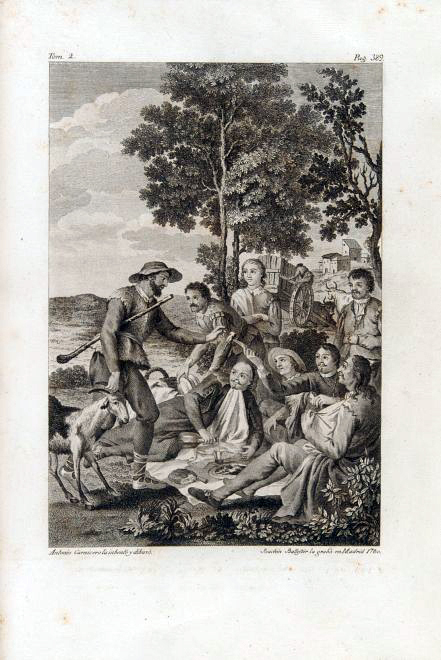Cervantes’s merienda looks like a picnic on the grass. It occurs while, Don Quixote and Sancho engage in a spirited discussion of the uses of enchantment and the power of imagination with the Canon, the curate, and the barber. They sit on the grass waiting for cold rabbit, pasties, and wine ordered from a local inn.
As Don Quixote defends the power of imagination and enchantment, while the Canon is incredulous that enchantment of any kind is healthy and results in blasphemy. Don Quixote suggests it is the Canon is deranged.
The argument, translated byEdith Grossman, ends when a goatherd chasing his goat Spotty interrupts the meal and mocks the conversation: “By this time, the Canon’s servants, who had gone to the inn to fetch the sumpter mule, had returned and making a carpet and the green grass of the meadow serve as a table, they seated themselves in the shade of some trees and made their repast there, that the carter might not be deprived of the advantage of the spot, as has been already said. As they were eating, they suddenly heard a loud noise and the sound of a bell that seemed to come from among some brambles and thick bushes that were close by, and the same instant they observed a beautiful goat, spotted all over black, white, and brown, spring out of the thicket with a goatherd after it, calling to it and uttering the usual cries to make it stop or turn back to the fold. The fugitive goat, scared and frightened, ran towards the company as if seeking their protection and then stood still, and the goatherd coming up seized it by the horns and began to talk to it as if it were possessed of reason and understanding: “Ah wanderer, wanderer, Spotty, Spotty; how have you gone limping all this time? What wolves have frightened you, my daughter? Won’t you tell me what is the matter, my beauty? But what else can it be except that you are she, and cannot keep quiet? A plague on your humours and the humours of those you take after! Come back, come back, my darling; and if you will not be so happy, at any rate you will be safe in the fold or with your companions; for if you who ought to keep and lead them, go wandering astray, what will become of them?”
Antonio Carnicero’s engraving for an edition of the novel by the Spanish Royal Academy accurately follows the text, illustrating how a goatherd chasing his errant goat just as they begin eating their cold rabbit, pasties, and wine Spotty, comically interrupts them. When asked to join the merienda, he offers his long unhappy tale about enchantment and despair as his contribution to an otherwise convivial meal.
Featured Image: Antonio Carnicero. Don Quixote and friends (Chapters XLIX-L)
See Miguel de Cervantes. Don Quixote De La Mancha Translated by Edith Grossman. New York: Ecco, 2003; Antonio Carnicero. (1780), engraving. Miguel de Cervantes Saavedra. Don Quixote de la Mancha (Madrid, 1780): José Rebelles. Don Quixote’s merienda (1819); https://repository.library.brown.edu/viewers/image/zoom/bdr:57372/highres_jp2/

